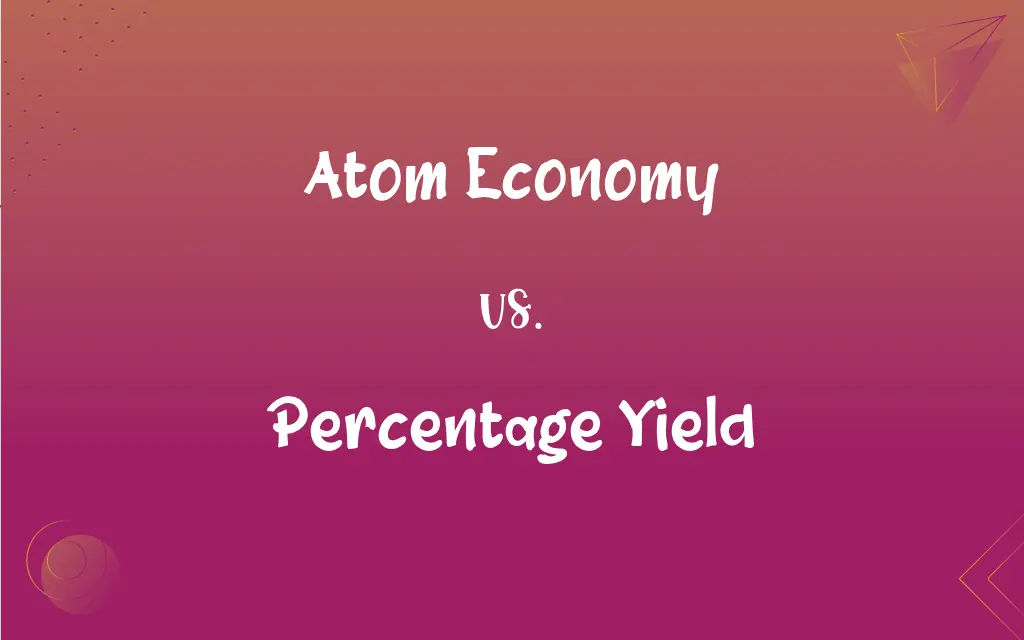Atom Economy vs. Percentage Yield: What's the Difference?
Edited by Aimie Carlson || By Janet White || Published on March 31, 2024
Atom economy measures the efficiency of a reaction in using all atoms in starting materials, whereas percentage yield measures the actual output of a product compared to the theoretical maximum.

Key Differences
Atom economy and percentage yield are both critical metrics in assessing the efficiency and sustainability of chemical reactions, yet they evaluate different aspects. Atom economy, a concept introduced by Barry Trost in 1991, focuses on the proportion of reactants that become part of the desired product, highlighting the environmental impact and resource utilization of chemical processes. Percentage yield, on the other hand, compares the actual quantity of product obtained from a reaction to the theoretical maximum possible quantity, as predicted by stoichiometric calculations based on reactant amounts and the balanced chemical equation.
Atom economy assesses the sustainability and efficiency of using raw materials in a reaction, emphasizing the design of processes that reduce waste and environmental impact, percentage yield measures the practical effectiveness of a reaction in producing the desired product. A high atom economy indicates a reaction that makes efficient use of all reactants, potentially reducing costs and environmental harm. A high percentage yield indicates a reaction where the conditions have been optimized to produce a maximum amount of product, reflecting on the reaction's operational efficiency.
These concepts are complementary; a process with a high atom economy may not always have a high percentage yield, and vice versa. A reaction with a high atom economy is environmentally favorable and resource-efficient, while a high percentage yield indicates that the reaction conditions are well-optimized to maximize the product output. Both are important for the development of sustainable and efficient chemical processes, with atom economy guiding the design of green chemistry routes and percentage yield ensuring the practical applicability of these processes in a laboratory or industrial setting.
Both atom economy and percentage yield are vital in evaluating chemical reactions, they serve different purposes. Atom economy focuses on the efficient use of materials at the molecular level, aiming to minimize waste and environmental impact. Percentage yield measures the effectiveness of a reaction in producing the desired product, critical for process optimization and practical yield maximization. Understanding both concepts is essential for chemists aiming to design efficient, sustainable, and environmentally friendly chemical processes.
Comparison Chart
Definition
Measures the proportion of reactants converted into desired product.
Measures the actual amount of product obtained vs. the theoretical maximum.
ADVERTISEMENT
Focus
Efficiency in using all atoms from reactants.
Efficiency in converting reactants to desired product.
Environmental Impact
High atom economy indicates a process that minimizes waste.
Not directly related to waste production, but higher yields mean less waste.
Economic Impact
Processes with high atom economy can be more cost-effective.
High percentage yields can indicate more cost-effective processes.
Chemical Process Design
Encourages the design of reactions that use materials efficiently.
Focuses on optimizing reaction conditions to maximize product yield.
Atom Economy and Percentage Yield Definitions
Atom Economy
Atom economy is a key metric in green chemistry, aiming to maximize the use of starting materials.
Achieving high atom economy reduces environmental impact.
ADVERTISEMENT
Percentage Yield
Percentage yield provides insight into the success of reaction optimization efforts.
Optimizing reaction conditions can significantly increase percentage yield.
Atom Economy
Atom economy evaluates the extent to which a chemical process utilizes its reactants efficiently.
Processes with improved atom economy are often more economical.
Percentage Yield
Percentage yield is crucial for assessing the practical effectiveness of a chemical synthesis.
Improving percentage yield is a common goal in chemical manufacturing.
Atom Economy
Atom economy reflects the efficiency of a reaction in incorporating all reactant atoms into the desired product.
A reaction with a high atom economy is preferable for sustainable chemistry.
Percentage Yield
Percentage yield is a key indicator of the scalability of a chemical process.
Scaling up a reaction with a high percentage yield is more economically viable.
Atom Economy
Atom economy measures the proportion of reactants that end up in the final product, minimizing waste.
High atom economy is a hallmark of green chemistry.
Percentage Yield
Percentage yield measures how much of the theoretical product is actually obtained from a reaction.
A high percentage yield indicates an efficient reaction process.
Atom Economy
Atom economy helps in designing chemical reactions that are environmentally friendly and efficient.
Designing a synthesis route with high atom economy is a priority in sustainable development.
Percentage Yield
Percentage yield quantifies the efficiency of a chemical reaction in terms of the actual versus theoretical product amount.
Even with perfect conditions, achieving 100% percentage yield is rare.
FAQs
How is atom economy calculated?
By dividing the mass of the desired product by the total mass of reactants, then multiplying by 100.
What is percentage yield?
It compares the actual product obtained to the theoretical maximum, indicating the reaction's effectiveness.
What is atom economy?
It measures the proportion of reactants converted into the desired product, highlighting efficiency and sustainability.
How do atom economy and percentage yield relate to green chemistry?
Both are metrics for assessing sustainability and efficiency, with atom economy focusing on material use and percentage yield on process optimization.
What affects percentage yield?
Reaction conditions, purity of reactants, and process efficiency.
How is percentage yield calculated?
By dividing the actual yield by the theoretical yield and multiplying by 100%.
Why is percentage yield important?
It measures the practical success of a reaction, crucial for optimizing and scaling processes.
Why is atom economy important?
It promotes sustainable chemistry by minimizing waste and improving resource utilization.
Can a reaction have high percentage yield but low atom economy?
Yes, if it produces a lot of the desired product but also generates waste.
How can percentage yield be increased?
Through optimizing reaction conditions and minimizing losses during product isolation.
Do atom economy and percentage yield affect the cost of a chemical process?
Yes, higher values in both can indicate more cost-effective and efficient processes.
How do industry and academia view atom economy and percentage yield?
Both sectors value these metrics for developing sustainable, efficient, and cost-effective chemical processes.
Can improving atom economy impact the environmental footprint of a process?
Yes, by reducing waste and improving the efficiency of material use, the environmental impact is lessened.
Can percentage yield be too high to be true?
If the reported percentage yield exceeds the theoretical maximum, it may indicate errors in measurement or calculation.
Can a reaction have high atom economy but low percentage yield?
Yes, if it efficiently uses atoms but conditions limit product formation.
How can atom economy be improved?
By designing reactions that produce fewer by-products and use reactants more efficiently.
Is atom economy always a priority in chemical synthesis?
It's a key factor in sustainable and green chemistry but must be balanced with other considerations like cost and reaction conditions.
Are atom economy and percentage yield the only metrics for evaluating chemical reactions?
No, but they are critical for assessing sustainability, efficiency, and the practicality of chemical processes.
What affects atom economy?
The reaction pathway and the stoichiometry of the reactants and products.
Is a high percentage yield always achievable?
It depends on the reaction's nature and how well it can be optimized, but 100% yield is rare.
About Author
Written by
Janet WhiteJanet White has been an esteemed writer and blogger for Difference Wiki. Holding a Master's degree in Science and Medical Journalism from the prestigious Boston University, she has consistently demonstrated her expertise and passion for her field. When she's not immersed in her work, Janet relishes her time exercising, delving into a good book, and cherishing moments with friends and family.
Edited by
Aimie CarlsonAimie Carlson, holding a master's degree in English literature, is a fervent English language enthusiast. She lends her writing talents to Difference Wiki, a prominent website that specializes in comparisons, offering readers insightful analyses that both captivate and inform.
































































